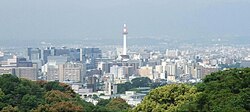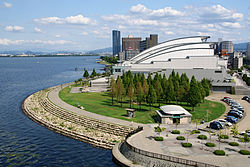Greater Kyoto
|
Kyoto Metropolitan Area Kyoto MEA |
|
|---|---|
| Urban Employment Area | |
 Kyoto Tower and Downtown Kyoto  Biwako Hall in Ōtsu |
|
| Coordinates: 35°0′N 135°46′E / 35.000°N 135.767°ECoordinates: 35°0′N 135°46′E / 35.000°N 135.767°E | |
| Country |
|
| Prefectures | |
| Core city |
|
| Area(2011) | |
| • Metro | 2,835.93 km2 (1,094.96 sq mi) |
| Population (2010) | |
| • Metro | 2,679,094 |
| • Metro density | 940/km2 (2,400/sq mi) |
| GDP | (2010) |
| Nominal | $115.3 billion |
| Website | www |
Greater Kyoto is a metropolitan area in Japan encompassing Kyoto, the capital of Kyoto Prefecture, as well as its surrounding areas including Ōtsu, the capital of Shiga Prefecture.
The metropolitan area is also referred to as Keiji (京滋) or Keishin (京津). The name Keiji is constructed by extracting a representative kanji from Kyoto (京都) and Shiga (滋賀). The name Keishin is constructed by extracting a representative kanji from Kyoto (京都) and Ōtsu (大津).
The greater Kyoto area is defined by Urban Employment Area as Kyoto Metropolitan Employment Area (Kyoto MEA). The metropolitan area had a total population of 2,679,049 as of 2010 and is the fourth-largest in Japan. The cities and towns of the metropolitan area with their 2015 populations are listed below.
A wider metropolitan area based on commuting patterns is also defined by Kyōto Toshiken Jichitai Nettowāku Kaigi (京都都市圏自治体ネットワーク会議, Conference of Kyoto metropolitan municipal network) as the Kyoto metropolitan area. This area consists of 14 cities and towns of Shiga Prefecture, Kyoto Prefecture, and Osaka Prefecture, in addition to Kyoto MEA. The total population as of 2015 for the region was estimated at 3,789,750. The following areas, along with the above Kyoto MEA, are included in the Kyoto metropolitan area, with their 2015 populations:
...
Wikipedia

